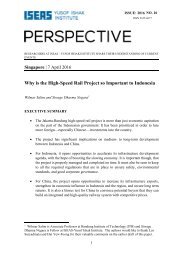NO.19
nscwps19_early_voyaging_south_china_sea_implications_territorial_claims
nscwps19_early_voyaging_south_china_sea_implications_territorial_claims
Create successful ePaper yourself
Turn your PDF publications into a flip-book with our unique Google optimized e-Paper software.
Flecker: Early Voyaging in the South China Sea NSC Working Paper No. 19… at 9 h. a.m. a low sandy island was discovered from the masthead, bearing S.E.bE.four leagues…. One [of these two dangers] I call Ladd Reef, after Captain Ladd of theShip Austen, who appears first to have seen it; the other Spratly’s Sandy Island. 1Captain Spratly may more precisely have stated that Captain Ladd was the firstEuropean to have seen Ladd Reef; however, even this may have been incorrect. Ladd Reefwas also named Robb Roy Shoal after the opium clipper of that name, which sailed theCalcutta China route during the 1840’s, and Spratly Island was initially named StormIsland by Horsburgh (or perhaps by Captain Ross who was assigned by Horsburgh tosurvey the Dangerous Ground in 1807).With the formalities out of the way, we proceeded with much anticipation to ourfirst priority.Ladd ReefFig. 3. A steel fishing boat wrecked on Ladd ReefCredit: Author.Ladd Reef is the western-most danger in the Dangerous Ground, and therefore the mostlikely to get in the way of shipping in the busy trade route along the western reaches ofthe South China Sea. On approaching this 3 mile long by 1 mile wide impediment, itswrecking potential was immediately apparent. A small tanker sat high and dry on the1 Hancox and Prescott 1995:15, citing Nautical Magazine 1843:697.4








